When it comes to indoor plant cultivation, it is important to remember that several variables can affect the overall health of your plants. Temperature, in particular, is a critical factor as an excessively hot or cold environment can easily cause your plants to suffer and hinder their growth. This is why grow tents are great, because they let you control the temperature and general environment for your indoor plants. However, if you’re not careful, your tent could overheat, so it is important to know how to keep your grow tent cool.
Because excessive heat is a prevalent problem among grow tent owners, here are seven tips to help you keep your grow tent cool:
- Add more fans
- Place an AC unit in the room
- Open all grow tent vents
- Keep your grow tent’s door open
- Use LED and not HPS grow lights
- Use your grow lights more efficiently
- Get a bigger grow tent
Keeping your grow tent’s temperature within a certain range will positively impact your plants. In this article, we will explore some of the easiest ways to keep your grow tent cool enough for your plants to grow strong and healthy—always keeping in mind that different plants have different heat tolerance levels.
As an Amazon Associate, I earn from qualifying purchases.
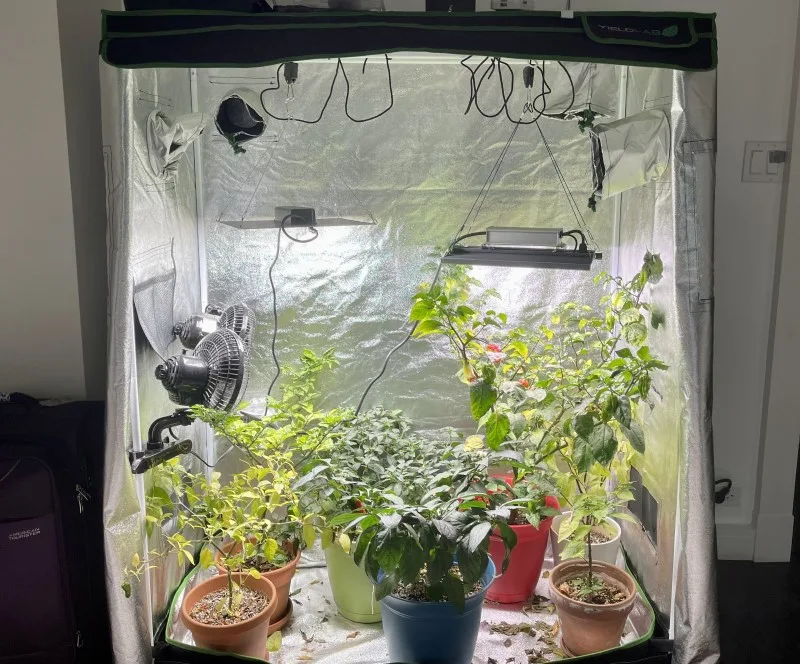
1. Add More Fans
Good ventilation is key to keeping a grow tent cool. Plants in their natural habitats benefit from the cooling power of wind, precipitation, and evaporation. Without these essential elements, plants will quickly overheat, which would ultimately cause them to die.
When growing plants indoors, you can easily recreate these elements with the help of fans. Every grow tent needs to be equipped with at least one regular fan and one extractor fan, each serving a specific purpose. If you leave your grow tent doors open a couple of grow tent fans will do the trick.
I personally leave my grow tent doors open and use two fans to circulate air.
A regular fan will keep air circulating within your grow tent while an extractor fan will blow out old, warm air and bring in fresh cool air.
There is a good chance that you will need more than one fan, as it is not unusual for grow tents to get quite hot, especially during the summer.
Adding more fans is a simple and relatively inexpensive way to keep your plants cool. Oscillating fans, in particular, are efficient and effective thanks to their ability to improve air circulation within a grow tent.
Oscillating fans will continuously and consistently blow air all over and around your plants, meaning that you will not have to worry about certain plants or a certain side of your plants getting more fresh air than others.
The best thing about oscillating fans is that they are straightforward to mount, although installing them before filling a grow tent with plants is always a good idea.
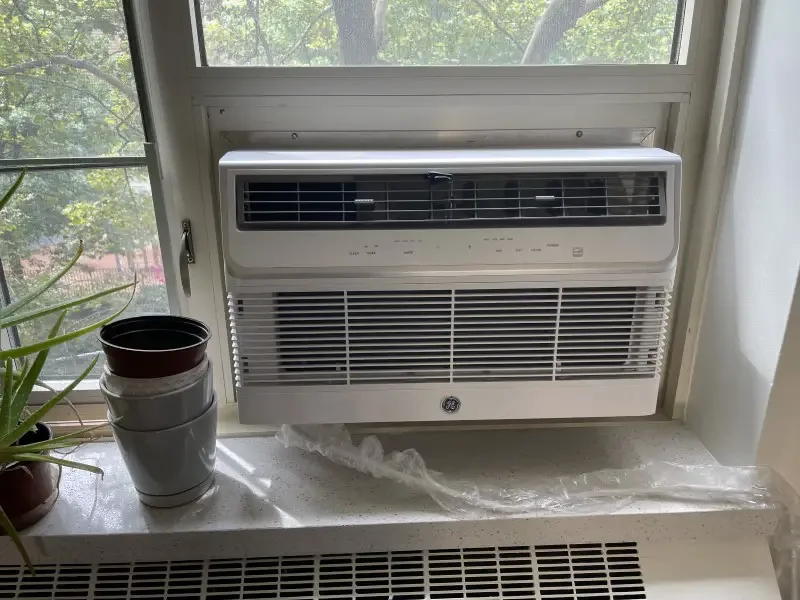
2. Place an AC Unit in the Room
Putting an AC unit in the room where your grow tent is located is an excellent way to keep your plants cool without much effort. While more expensive than some of the solutions discussed in this article, an AC unit will quickly lower the temperature inside your grow tent.
This effectively counteracts the heating effect of all the equipment required when growing plants indoors.
So, what sort of AC unit should you get for your tent? The answer depends on four key factors:
- How big your grow tent is
- What plants you are growing (how sensitive they are to fluctuating temperatures)
- How hot your grow tent is
- How much you are willing to spend.
The bigger and hotter your grow room is, and the more sensitive your plants are, the more powerful your AC unit will have to be. If you have a large setup with plenty of extra equipment, you will need a more powerful AC unit—we recommend at least 12,000 BTU.
Of course, a more powerful AC unit will also cost you more as your electricity bills will inevitably rise if you keep one on most of the time.
For this reason, I suggest you try the other solutions listed in this article before investing in an expensive AC unit.
I use a window AC unit that we turn on for our grow tent set up on hot days.
3. Open All Grow Tent Vents
This is the easiest and cheapest (completely free) way to cool down a grow tent. Grow tents typically come with multiple vents that can be kept closed or open, depending on whether one needs to create a warmer or cooler growing environment for one’s plants.
Sometimes, keeping all vents open is enough to lower a grow tent’s temperature, as hot air will slowly exit the grow tent and be replaced with fresh, cool air.
I keep all my grow tent’s vents wide open to maximize airflow throughout the tent.
4. Keep Your Grow Tent’s Door Open
Like the previous solution, this one is also completely free. All grow tents come with a door that can be quickly zipped up or down or snapped shut. Zipper doors are extremely convenient as they grant growers like yourself easy access to their plants.
By keeping your grow tent’s door open, hot air will continuously flow out of your tent, and your plants will enjoy plenty of fresh air.
I always keep my grow tent doors open as it helps ensure proper ventilation, and we can always see how our plants are doing.
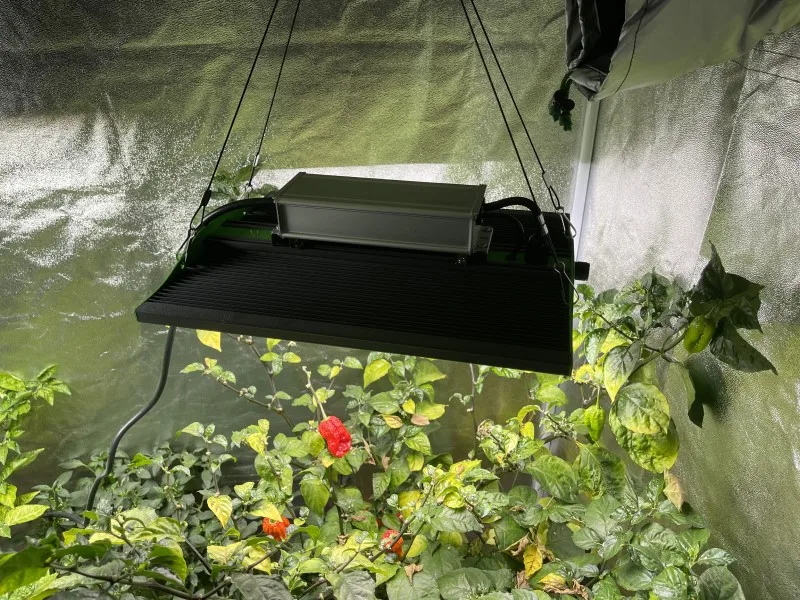
5. Use LED and Not HPS Grow Lights
Grow lights are essential in stimulating plants’ photosynthesis as they transform electrical energy into photons, or elementary light particles. You will need a good set of grow lights for your grow tent or grow room as an indoor grower to help stimulate plant growth.
However, the main problem with grow lights is that they can get very hot, which is not good if your plants require a cool climate to grow and thrive.
High-pressure sodium lights, more commonly known as HPS lights, are among the most common types used in grow tents and rooms.
These particular lights have been developed specifically for indoor plant cultivation as they emit a powerful reddish light that simulates the natural light that the sun emits in autumn when flowering plants tend to bloom.
Unlike other types of lights, HPS lights emit a very intense light that is ideal when growing plants requiring a lot of sunlight, such as flowering plants.
HPS lights are very intense, however, and tend to get hotter than other types of lights, which is why you may want to consider alternative lighting options.
LED grow lights, for instance, are good alternatives as they are engineered to mimic the solar spectrum by providing plants with a balanced combination of three lights (green, red, and blue).
It is crucial to remember that, unlike LED grow lights, regular LED lights are not suitable for indoor plant cultivation. Besides being less intense than LED grow lights, regular LED lights are unlikely to offer an optimal mix of green, blue, and red lights, which are the colors needed to maximize plants’ growth.
Plants are particularly responsive to red light, which is why some growers incorporate 100% red LED lights to encourage their plants to grow faster and stronger. Other colors are also important but must be balanced correctly to achieve higher yields.
I use a Viparspectra P1500 grow LED and love it because it has a heat sink which keeps temperatures down and has all the crucial light spectrums to facilitate strong plant growth.
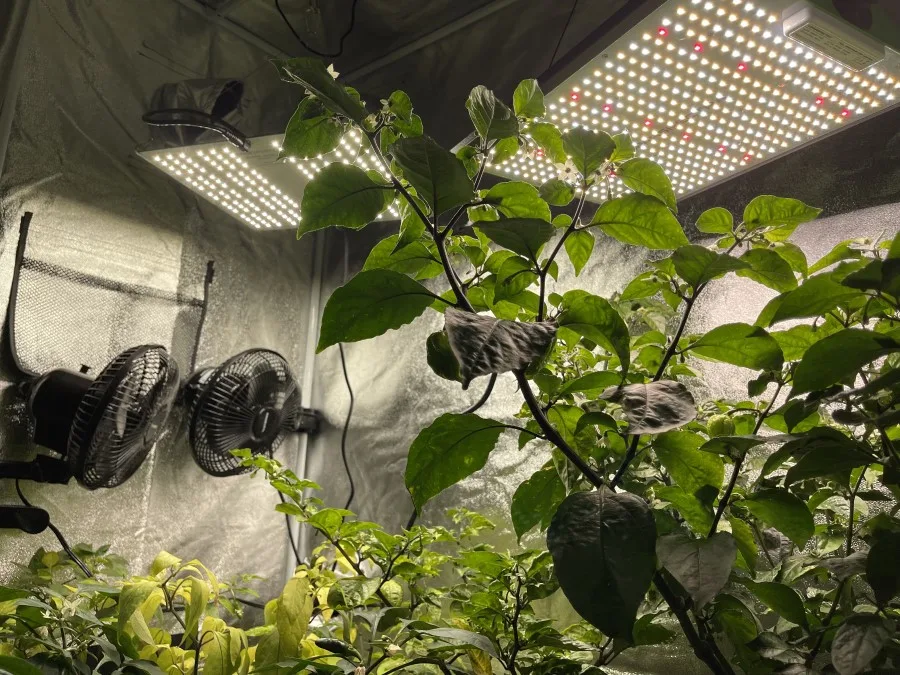
6. Use Your Grow Lights More Efficiently
No matter what type of grow lights you are using, you may cool down your grow tent by simply minimizing the amount of heat they emit. To do so, implement the following strategies:
- Place your grow lights further away from your plants.
- If possible, do not run your lights during the day, but keep them on throughout the night, when temperatures are usually lower.
- Distribute the lights evenly inside your tent to avoid creating hot spots
- Use a plug timer so your grow lights automatically get turned on and off at ideal times, whether you are at home or not.
I use a BL-Link 24 Hour plug-in timer to perfectly control when our grow lights are on or off.
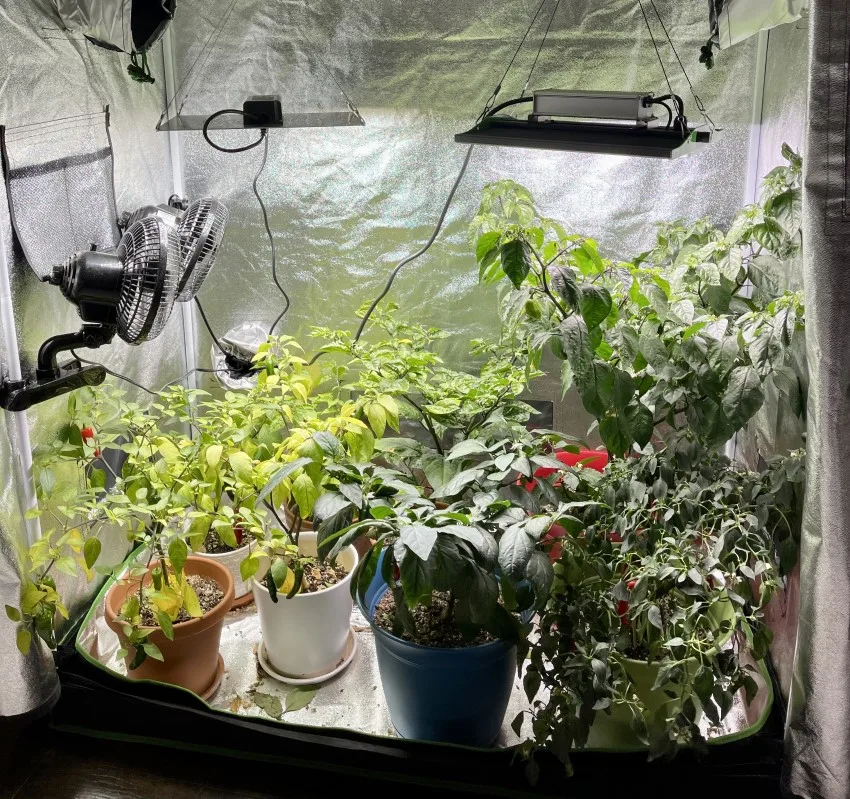
7. Get a Bigger Grow Tent
If you have already invested in a grow tent, you may be unwilling to spend your hard-earned money on a bigger grow tent, which is perfectly understandable! Before you discard this tip, you may want to ask yourself whether a bigger tent may actually work for you, as a cooler growing environment for your plants is only one benefit you would enjoy.
First of all, keep in mind that a bigger tent will not get as hot as a smaller one. With this, you save yourself the trouble and energy of having to implement the other solutions listed in this article.
Second, a bigger grow tent would allow you to grow more plants, translating into higher yields.
I purchased a Yield Lab 48″ x 24″ x 60″ grow tent for our pepper plants, in hindsight, we wish we had chosen a slightly wider and higher grow tent to grow more plants!
Closing Thoughts
There are several ways to keep your grow tent cool, some easier than others. If your tent is only slightly overheated, you may want to try leaving the vents and door open for some time.
This way, your plants will enjoy plenty of fresh air, without you buying any additional gadgets. If these tricks prove unsuccessful, you may want to try different solutions, such as investing in an AC unit or a set of LED grow lights with a timer.
These simple yet effective solutions will allow you to keep your grow tent’s temperature within a suitable range.
